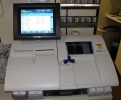Arterial Blood Gases
Original Editor - Scott Buxton
Top Contributors - Adam Vallely Farrell, Kim Jackson, Uchechukwu Chukwuemeka, Scott Buxton, Lucinda hampton, Rachael Lowe, Joao Costa, Admin, Abbey Wright, Angeliki Chorti, 127.0.0.1, Laura Ritchie and Naomi O'Reilly
Arterial Blood Gases[edit | edit source]
Arterial blood gases (ABG's) is a blood test which is used to give an indication of ventilation, gas exchange and acid-base status and is taken from an arterial blood supply[1]. It should be noted that it is not to be confused with venous blood gases which are used when arterial supply is not available or unreliable due to disease. The line in is usually interted in the radial artery located at the wrist but is also sometimes used in the femoral artery in the groin[1]. This is important to consider when moving and handling a patient as it is easy to catch a line on an obect or clothing and care needs to be taken.
It can be argued that one of the most important clinical uses of ABG analysis is to assess if a patient is in Type 1 or Type 2 respiratory failure and it is important that you become able to quickly and correctly interpret this.
ABGs give us information about the activity in both the respiratory system and the 'metabolic' system. If one system is disturbed, the other will try to restore the balance. Both systems work together in an attempt to keep pH in the normal range. They are commonly used to; identify acid/base disorders, identify gas exchange problems, monitor the effects of oxygen therapy.
ABG Definitions[edit | edit source]
- PH: The measure of hydrogen ions in the blood
- PaC02: Partial pressure of Carbon Dioxide in the blood, the acidic element of the balance
- Acidic component
- Indicator of respiratory function
- Changes rapidly to compensate
- Pa02: Partial pressure of oxygen in the blood.
- HCO3-: Bicarbonate ion concentration in the blood, the basic element of the balance
- Basic/Alkaline component
- Indicator of metabolic function
- Compensation is slower
- BE: Base Excess = quantity of strong acid or base that is required to restore pH to normal
Readings[edit | edit source]
| Arterial Blood Analysis | Reference Ranges | Venous Blood analysis | Reference Ranges |
|---|---|---|---|
| pH | 7.35 - 7.45 | pH | 7.31 - 7.41 |
| PaO2 |
10.7 - 13.3 kPa |
PO2 |
5.0 - 5.6 kPa |
| PaCO2 | 4.7 - 6.0 kPa | PCO2 | 5.6 - 6.7 kPa |
|
Bicarbonate (HCO3-) |
22 - 26 mmol/L | ||
| Base Excess | -2 to +2 |
Acid-Base Balance[edit | edit source]
- pH
- Reflects acid-base balance and responds to metabolic and respiratory change. Body cells and chemical reactions are acutely sensitive to the pH of their environment.
- Lower pH = Acidic
- Higher pH= Alkaline
- Reflects acid-base balance and responds to metabolic and respiratory change. Body cells and chemical reactions are acutely sensitive to the pH of their environment.
- Regulation
- Acid-base balance is disturbed if; CO2 removal by the lungs is abnormal, production of acid from tissues is abnormal, and removal of acid is abnormal.
- Deviation from normal pH is resisted by 3 mechanisms;
- The Buffering system
- Acts like a chemical sponge and neutralises acids and bases.
- The Lungs
- The respiratory component that reacts if the buffering system is not enough and the lungs help my regulating CO2.
- The Kidneys
- The Metabolic component and is the last mechanism to work and begins to eliminate acid.
Respiratory Acidosis[edit | edit source]
- Decreased pH
- Increased PaCO2
- Causes
- Hypoventilation
- Acute Lunge Injury
- Upper airway obstruction
- Lower airway obstruction
- Impaired alveolar filling
- Chronic Lung Disease
- Neuromuscular disorders
- Obesity
- CNS Depression
- Symptoms
- Headache
- Anxiety
- Blurred vision
- Restlessness
- Drowsiness
- Tremors
- Delirium
- Coma
Helpful guidelines[3]
1.A 1mmHg change in PaCO2 above or below 40 mmHg results in 0.008 unit change in pH in the opposite direction.
2.The PaCO2 will decrease by about 1 mmHg for every 1 mEq/L reduction in [HCO3-] below 24 mEq/L
3.A change in [HCO3-] of 10 mEq/L will result in a change in pH of approximately 0.15 pH units in the same direction.
The results should always be read and compared in reference to the patients previous ABG (if available) as you will then be able to assess a trend and make a more accurate assessment on whether you should treat or if your treatment has be successful or not.
Useful Resources[edit | edit source]
Associated Topics[edit | edit source]
- Oxygen Dissociation Cure
- Anemia
- Respiratory Failure
- Oxygen Therapy
References
[edit | edit source]
- ↑ 1.0 1.1 Hough A. Physiotherapy in Respiratory Care. An evidence based-approach to respiratory and cardiac managemenmt. 3rd ed. Cheltenham: Nelson Thomas Ltd. 2001
- ↑ Kenyon K, Kenyon J. The Physiotherapist's Pocketbook. Essential Facts at your Fingertips. 2nd ed. London: Churchill Livingstone, Elsevier. 2009.
- ↑ Stoeltin RK, Miller RD. Basics of Anesthesia, 5th ed. Philadelphia: Churchill Livingstone, Elsevier. 2007.







